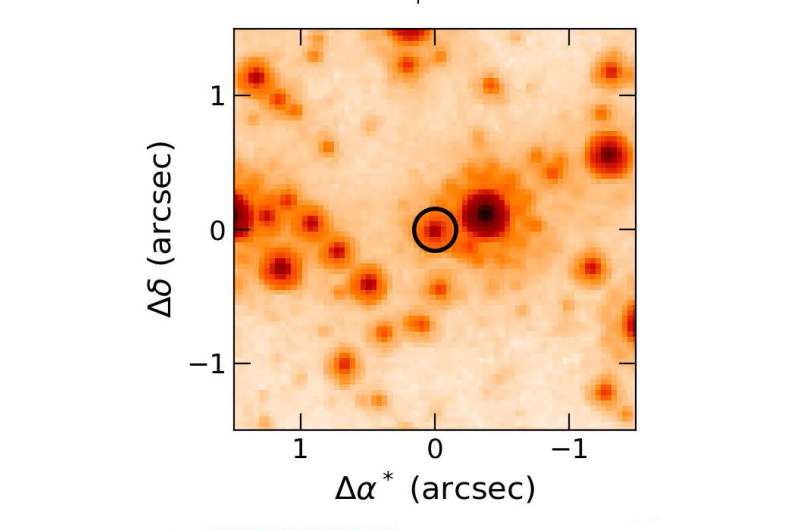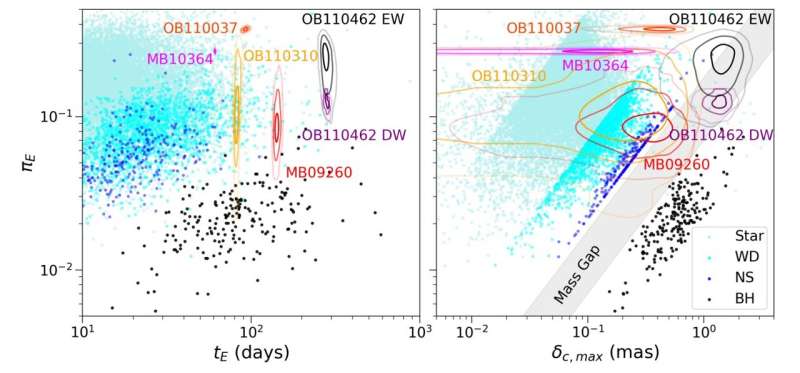Astronomers may have detected a ‘dark’ free-floating black hole

If, as astronomers believe, the deaths of large stars leave behind black holes, there should be hundreds of millions of them scattered throughout the Milky Way galaxy. The problem is, isolated black holes are invisible.
Now, a team led by University of California, Berkeley, astronomers has for the first time discovered what may be a free-floating black hole by observing the brightening of a more distant star as its light was distorted by the object’s strong gravitational field—so-called gravitational microlensing.
The team, led by graduate student Casey Lam and Jessica Lu, a UC Berkeley associate professor of astronomy, estimates that the mass of the invisible compact object is between 1.6 and 4.4 times that of the sun. Because astronomers think that the leftover remnant of a dead star must be heavier than 2.2 solar masses in order to collapse to a black hole, the UC Berkeley researchers caution that the object could be a neutron star instead of a black hole. Neutron stars are also dense, highly compact objects, but their gravity is balanced by internal neutron pressure, which prevents further collapse to a black hole.
Whether a black hole or a neutron star, the object is the first dark stellar remnant—a stellar “ghost”—discovered wandering through the galaxy unpaired with another star.
“This is the first free-floating black hole or neutron star discovered with gravitational microlensing,” Lu said. “With microlensing, we’re able to probe these lonely, compact objects and weigh them. I think we have opened a new window onto these dark objects, which can’t be seen any other way.”
Determining how many of these compact objects populate the Milky Way galaxy will help astronomers understand the evolution of stars—in particular, how they die—and of our galaxy, and perhaps reveal whether any of the unseen black holes are primordial black holes, which some cosmologists think were produced in large quantities during the Big Bang.
The analysis by Lam, Lu and their international team has been accepted for publication in The Astrophysical Journal Letters. The analysis includes four other microlensing events that the team concluded were not caused by a black hole, though two were likely caused by a white dwarf or a neutron star. The team also concluded that the likely population of black holes in the galaxy is 200 million—about what most theorists predicted.
Same data, different conclusions
Notably, a competing team from the Space Telescope Science Institute (STScI) in Baltimore analyzed the same microlensing event and claims that the mass of the compact object is closer to 7.1 solar masses and indisputably a black hole. A paper describing the analysis by the STScI team, led by Kailash Sahu, has been accepted for publication in The Astrophysical Journal.
Both teams used the same data: photometric measurements of the distant star’s brightening as its light was distorted or “lensed” by the super-compact object, and astrometric measurements of the shifting of the distant star‘s location in the sky as a result of the gravitational distortion by the lensing object. The photometric data came from two microlensing surveys: the Optical Gravitational Lensing Experiment (OGLE), which employs a 1.3-meter telescope in Chile operated by Warsaw University, and the Microlensing Observations in Astrophysics (MOA) experiment, which is mounted on a 1.8-meter telescope in New Zealand operated by Osaka University. The astrometric data came from NASA’s Hubble Space Telescope. STScI manages the science program for the telescope and conducts its science operations.
 Microlensing parallax πE vs. Einstein crossing time tE (left) and maximum astrometric shift δc,max (right). Points are from the PopSyCLE simulation. Contours are 1 − 2 − 3σ (39.3-86.5-98.9%) credible regions from the microlensing model fits to the five BH candidates. There are two fits for OB110462 (default weight (DW) and equal weight (EW).The OB110462 DW solution has a smaller πE than the OB110462 EW solution, and has a correspondingly more massive lens mass. Both solutions fall solidly in the NS-BH mass gap, making OB110462 the best BH-candidate. MB09260 and OB110310 are most likely white dwarfs or neutron stars, although due to uncertainty in πE and δc,max higher and lower mass lenses cannot be definitively ruled out. OB110037 and MB10364 are not BHs as they have very large πE, as well as relatively short tE and small δc,max. Credit: The Astrophysical Journal Letters (2022). DOI: 10.48550/arXiv.2202.01903
Microlensing parallax πE vs. Einstein crossing time tE (left) and maximum astrometric shift δc,max (right). Points are from the PopSyCLE simulation. Contours are 1 − 2 − 3σ (39.3-86.5-98.9%) credible regions from the microlensing model fits to the five BH candidates. There are two fits for OB110462 (default weight (DW) and equal weight (EW).The OB110462 DW solution has a smaller πE than the OB110462 EW solution, and has a correspondingly more massive lens mass. Both solutions fall solidly in the NS-BH mass gap, making OB110462 the best BH-candidate. MB09260 and OB110310 are most likely white dwarfs or neutron stars, although due to uncertainty in πE and δc,max higher and lower mass lenses cannot be definitively ruled out. OB110037 and MB10364 are not BHs as they have very large πE, as well as relatively short tE and small δc,max. Credit: The Astrophysical Journal Letters (2022). DOI: 10.48550/arXiv.2202.01903Because both microlensing surveys caught the same object, it has two names: MOA-2011-BLG-191 and OGLE-2011-BLG-0462, or OB110462, for short.
While surveys like these discover about 2,000 stars brightened by microlensing each year in the Milky Way galaxy, the addition of astrometric data is what allowed the two teams to determine the mass of the compact object and its distance from Earth. The UC Berkeley-led team estimated that it lies between 2,280 and 6,260 light years (700-1920 parsecs) away, in the direction of the center of the Milky Way Galaxy and near the large bulge that surrounds the galaxy’s central massive black hole.
The STScI group estimated that it lies about 5,153 light years (1,580 parsecs) away.
Looking for a needle in a haystack
Lu and Lam first became interested in the object in 2020 after the STScI team tentatively concluded that five microlensing events observed by Hubble—all of which lasted for more than 100 days, and thus could have been black holes—might not be caused by compact objects after all.
Lu, who has been looking for free-floating black holes since 2008, thought the data would help her better estimate their abundance in the galaxy, which has been roughly estimated at between 10 million and 1 billion. To date, star-sized black holes have been found only as part of binary star systems. Black holes in binaries are seen either in X-rays, produced when material from the star falls onto the black hole, or by recent gravitational wave detectors, which are sensitive to mergers of two or more black holes. But these events are rare.
“Casey and I saw the data and we…
Read More: Astronomers may have detected a ‘dark’ free-floating black hole

